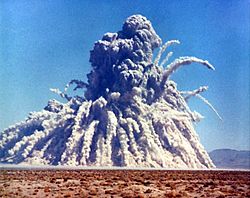Sedan (nuclear test)
| Storax Sedan | |
|---|---|

Storax Sedan explosion.
|
|
| Information | |
| Country | United States |
| Test series |
Operation Storax Operation Plowshare |
| Test site | Nevada Test Site |
| Date | July 6, 1962 |
| Test type | Underground |
| Yield | 104 kt |
Storax Sedan was a shallow underground nuclear test conducted in Area 10 of Yucca Flat at the Nevada National Security Site on 6 July 1962 as part of Operation Plowshare, a program to investigate the use of nuclear weapons for mining, cratering, and other civilian purposes. The radioactive fallout from the test contaminated more US residents than any other nuclear test. The Sedan Crater is the largest man-made crater in the United States, and is listed on the National Register of Historic Places.
Sedan was a thermonuclear device with a fission yield less than 30% and a fusion yield about 70%. According to Carey Sublette, the design of the Sedan device was similar to that used in Shot Bluestone and Swanee of operation Dominic conducted days and months prior to Sedan respectively, and was therefore not unlike the W56 high yield Minuteman I missile warhead. The device had a diameter of 43 cm (17 in), length of 96.5 cm (38.0 in), and a weight of 212.2 kg (468 lb).
The timing of the test put it within the Operation Storax fiscal year, but Sedan was functionally part of Operation Plowshare, and the test protocol was sponsored and conducted by Lawrence Livermore National Laboratory with minimal involvement by the United States Department of Defense. The explosive device was lowered into a shaft drilled into the desert alluvium 194 m (636 ft) deep. The fusion-fission blast had a yield equivalent to 104 kilotons of TNT (435 terajoules) and lifted a dome of earth 90 m (300 ft) above the desert floor before it vented at three seconds after detonation, exploding upward and outward displacing more than 11,000,000 t (11,000,000 long tons; 12,000,000 short tons) of soil. The resulting crater is 100 m (330 ft) deep with a diameter of about 390 m (1,280 ft). A circular area of the desert floor five miles across was obscured by fast-expanding dust clouds moving out horizontally from the base surge, akin to pyroclastic surge. The blast caused seismic waves equivalent to an earthquake of 4.75 on the Richter scale. The radiation level on the crater lip at 1 hour after burst was 500 R per hour (130 mC/(kg·h)), but it dropped to 500 mR per hour after 27 days.
...
Wikipedia
